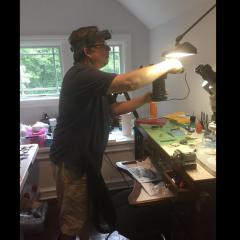-
Recently Browsing
- No registered users viewing this page.
-
Topics
-
Posts
-
By Neverenoughwatches · Posted
If you tend to be a little heavy handed then heres something that might help you to prevent cap jewel loses if you have some spare tweezers. File a round into each of the tips so you can grip a capstone or chaton while oiling or moving them around. Instead of filing along the length, angle file the tips first then file the rounds perpendicular to the angle. This way the tweezers wont get in the way of the oiler. Choose an angle that suits your natural hand grip position. The tweezers can now grip round parts on four sides Instead of two that often flip that part away. -
I had noticed that video before. He has a separate video for the reassembly. When he started the reassembly with using peg wood to oil a jewel I have to admit that I didn't watch much further. He also advocated not lubricating the center wheel arbor because the cannon pinion is friction fit. There is also a blog post (Adventures in Watchmaking, I think) that has a bit of info but not much at all with the oiling.
-
By HectorLooi · Posted
In view of the modern lubricants available, would you lubricate a clock movement differently today? -
By Neverenoughwatches · Posted
Yep thats the way it goes. The trick is to lead it into a false sense of security. Go through all the motions of ordering another one but dont actually click that final buy it now button, then stand up say " oh well at least I have another one on the way" . It will pop its head out and shout " SUCKER ! " . They've done studies you know 60% of the time it works everytime. -
By watchweasol · Posted
Hi. I used to live in Tadcaster nor York , there for 40 yrs moved Aberdeenshire as the place was falling apart. If you need anything just ask the members on here are very good and patient.
-






Recommended Posts
Join the conversation
You can post now and register later. If you have an account, sign in now to post with your account.
Note: Your post will require moderator approval before it will be visible.